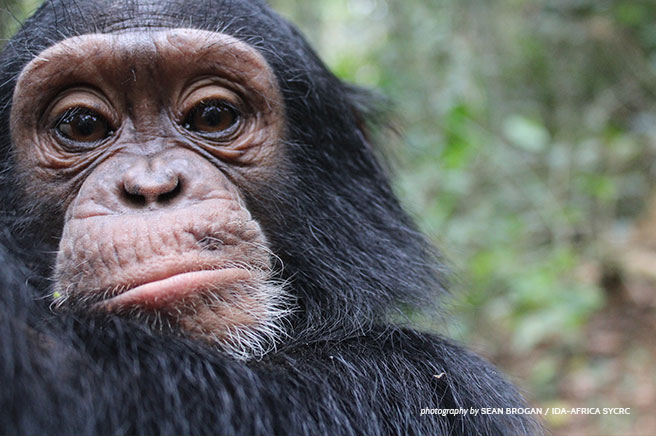Cameroon’s Vanishing Great Apes

Seventeen people, five days, 90 km (60 mi). This was the Walk Through Dja, a trek arranged by AWF and the national wildlife authority to get an inside look at the true state of Cameroon’s Dja Faunal Reserve.
Dja measures 5,260 sq. km, or 1.3 million acres. Because of its massive size and the limited resources of the Cameroonian wildlife authority, the World Heritage Site is not regularly traversed. “AWF has been assisting Dja’s protected area authority to target its patrols for greatest efficiency and effectiveness. But not surprisingly, there has been limited information about what might be happening in the middle of the reserve,” said Jef Dupain, AWF’s technical director for West and Central Africa, who arranged and led the trek.
The walk was memorable, to say the least. The hikers—among them individuals from the International Union for Conservation of Nature (or IUCN) and the European Union representative for environmental programs in Cameroon—crossed through dense foliage and chest-high water that often slowed their pace down to 1 – 2 km per hour. They hiked in temperatures that peaked at 95 degrees Fahrenheit, and experienced sudden rainstorms. They endured humidity levels that occasionally reached 85 percent. But perhaps the most memorable part of the walk was the near-total absence of wildlife sightings.
‘No single conservation activity’
More than 50 mammal species are said to be found in Dja. The team documented signs of wildlife—dung or tracks of forest elephants, gorillas and chimpanzees, for example. But they were shocked by the low abundance of these key species. “Dja is virgin forest, with habitat quite untouched—but it’s a bit of a deception,” explained Dupain following the trek. “There seems to be a lot of hunting going on. We encountered more signs of poaching than signs of wildlife.”
The experience underscores the need for conservation intervention if great apes, elephants and other large mammals are to survive in Dja and elsewhere across Central Africa. Africa’s great ape populations are already doing poorly: All four of the great ape species found in Africa are endangered or critically endangered. Causes include bushmeat hunting, deforestation and the transfer of disease from humans.
In Cameroon, AWF has been partnering with the Ministry of Forests and Wildlife for quite a few years, providing training and equipment in ecological monitoring in Dja as well as in Faro, Bouba N’Djida and Campo Ma’an National Parks. Thus immediately after the Dja Walk, Dupain was able to meet with representatives from the Ministry to discuss how best to address the poaching and lack of wildlife in the World Heritage Site.
In general, however, a number of significant barriers exist to working in Central Africa: Vast, remote locations with little infrastructure. Limited oversight by the national government. Limited capacity. In an increasing number of places, insecurity adds another complicating factor. Take Bili–Uele. Despite being the largest complex of protected areas in northern Democratic Republic of the Congo, Bili–Uele lacks any presence by the Congolese wildlife authority, Institut Congolais pour la Conservation de la Nature (ICCN). “No single conservation or protection activity is happening here,” says Dupain. Until the 1990s, little was even known about this area. In 2012, AWF supported researcher Cleve Hicks in conducting biodiversity surveys in the complex, which found that Bili-Uele has the largest population of eastern chimpanzees on the continent, as well as a sizeable forest elephant population. Unfortunately, the threats to the wildlife are sizeable too. The ivory trade has reportedly decimated an elephant population that was once in the tens of thousands. Artisanal mining, particularly for gold, is destroying the ecosystem, while pastoralists—with poachers amongst them—freely enter the complex with their livestock herds. Now, AWF has partnered with Maisha Consulting, a company experienced in implementing protected-area work in war or semi-war zones, to move forward in this critical ecosystem.
We have identified a core area of 10,000 sq. km to focus our protection and monitoring. The Bili–Mbomu Forest Savanna Mosaic is a span of untouched habitat that transitions from savanna along the Mbomu River in the north to the forest along the Bili River in the south. This area boasts high levels of biodiversity, low levels of habitat destruction and the highest potential for effective protection as compared to the rest of the complex. AWF has already opened an office nearby and coordinated with ICCN to hire a conservator for the protected area. The partners have also met with local communities to discuss planned interventions. While relationships between the locals and outside groups have not always been positive, “they really support the idea of having a permanent ICCN/AWF presence in Bili to improve security in the region,” relates Dupain.
Other benefits
Beyond improved security, the community stands to benefit in other ways. AWF and Maisha have assisted ICCN in selecting and training potential park rangers for Bili–Mbomu, with half coming from the local communities. Rangers were selected per existing ICCN criteria, then given training on a range of topics, including understanding and applying Congolese wildlife law, preventing ambushes and using handheld technologies for improved anti-poaching and ecological monitoring. “For the first time, this area will be actively managed and an important population of chimpanzees and elephants will be protected from human activity.” With all the challenges here, it’s not expected to be the ultimate cure for what ails Bili–Mbomu or other protected areas in Central Africa. But, like the Dja Walk in Cameroon, it is, perhaps, a start.